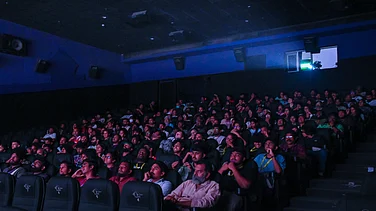“Any room for me in this new paradise?”
—Alfredo, Cinema Paradiso
It could be the final page of a life lived with all its beautiful and tragic moments, its abandonments and nostalgia, the growing imprints of ‘globalisation’ and ‘development’ and of a village where a projectionist knew about the world via reels that came to him through the Western Railways.
The Last Film Show, India’s entry to the Oscars in the international feature film category is an obituary, an ode, a reminder that people known as operators fell through the cracks. These people sat in booths and converted light into stories, which then became films. It is a memoir about light itself, about the last people to have touched a film reel, about moving on and returning. That’s how the filmmaker saw it as a child. Through the eyes of a nine-year-old boy called Samay.

The name is a metaphor. A metaphor chosen carefully since all metaphors have implications. It is the about the passing of time, about the passing of many things, tragic and otherwise. The inevitability of it all. Yet, there are things that defy time. Like memory.
The story is set in an old dusty town where a film projectionist tells a young boy that the future belongs to storytellers. It is set in 2010, a year before the digital took over and people like Mohammadbhai quit the booths. The dancing beams of light coming from a porthole became obsolete.

The photochemical film disappeared from the movie-making experience and digital projection began to be used across multiplex and single screen formats across India. It all happened within a decade starting from 1999 and by 2011, as Pan Nalin, the director of the film says, lakhs of projectionists like Mohammadbhai had been rendered jobless. In his director’s statement, Nalin says his heart has remained broken for over a decade.
“When the world took away the film from me; it was almost like taking away the red or blue or yellow colour from an artist who paints. How can an artist be forever red-less or blue-less?,” he asks. The only way was to resurrect some of those memories of him growing up in a small village in Amreli in Gujarat, watching light become a story and then, a film.
“It all started when I saw my first film. Ever since, there has been that constant obsession to catch the light.
That physical light, which the lens gathers.
That physical light, which the aperture controls.
That physical light, which the shutter cuts.
That physical light, which the film records,” he writes.
It is a film that celebrates recorded light. It is a film that celebrates the life of a projectionist. Mohammadbhai passed away during the pandemic. But he knew the little boy who became a director was making a film on their friendship, on light and on memory.

So many memories. Like how the children in the village began to steal mirrors from their houses in their attempt to create a kind of projector. They stole bulbs and film cans from the Western Railways because he says everything that came to their part of the world was brought by the railways. The film follows a similar trajectory where the little boy cracks a ‘food-for-films’ deal with the projectionist at Galaxy Cinema. Back then, each reel held up to 2,000 feet of film that made up for 15-20 minutes of a movie. They used to be packed in boxes. Now, it is all encrypted in what they call a digital cinema package or DCP—a military-grade hard disk.
‘Development,’ technology etc. took over like they always do. With a lot of forgetting and without guilt. Nalin remembered. But there is a world that exists beyond the cacophony of ‘development’ and ‘advancement’ and the democratisation of distribution. It is a world of memories. Nalin remembers and through his film, he transfers some of those memories to the people who might have been witness to the transition or to those who might want to know what the world was like before multiplexes came and advocated for an aspirational stylised, privatised, class and caste-based experience of cinema hall.
The chaos of the stand-alone, single-screen cinema in India open to the working classes was gone. The politics of exclusion entered the theatre space with the multiplex cinema that was part of the leisure infrastructure of the ‘global middle class’ as opposed to the social space that a single-screen represented.
In the multiplex world order, many things have been rendered obsolete. Like those reels in warehouses that lay in dark rooms with no hope for redemption. That’s where Nalin found them for his film, in warehouses in small towns.NIn the film, Fazal who embodies Mohammadbhai says the game was all about knowing how to tell lies. Samay says he was good at telling lies. The film has neither lies nor absolute truths. It lingers between nostalgia and a place that doesn’t exist anymore, like the booth. Remembrance is that. It doesn’t swear any allegiance to any ideological frameworks like capitalism and ‘development.’ The film is a memory reel much like Cinema Paradiso where Alfredo, a projectionist, says it meant being alone, watching the same films over and over again. The Italian film is a fictionalized account of how director Guiseppe Tornatore began a life-long affair with the medium of cinema just like Nalin. “And you start talking to Greta Garbo and Tyrone Power like a nut,” says Alfredo to Salvatore, a young boy who wants to learn how to operate a projector.“In 2011, across the world most celluloid went away. Mohammadbhai used to be in big demand. When the digital came, they all got fired. Around 2-3 lakh people, according to him, were laid off simply because they didn’t know technology. They are still jobless and roaming here and there,” Nalin says.
In Cinema Paradiso, Alfredo tells Salvatore that whatever he ends up doing, he should love it. “The way you loved the projection booth when you were a little squirt,” he says. And it is that love for light that inspired the film. The light that becomes a story. The story that then becomes a film. And the projectionist who made it all possible and who foresaw the heartbreak that was to come. It came. But memory trumps everything. These were the footsoldiers of the cinema who got lost in time. The below-the-line workers who disappeared.
“I remember Mohammadbhai,” says Nalin.

























